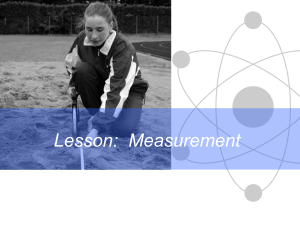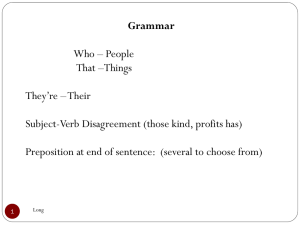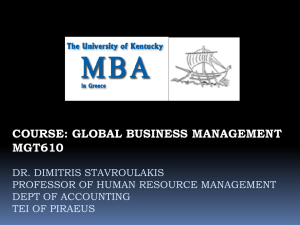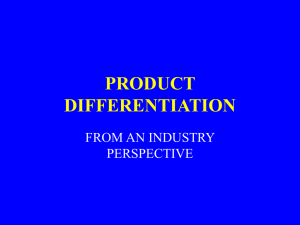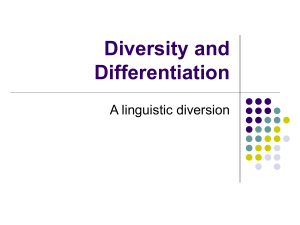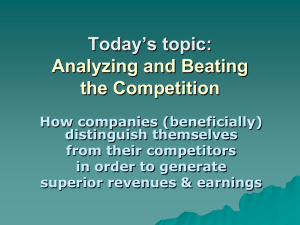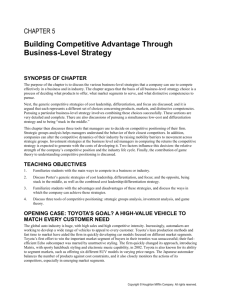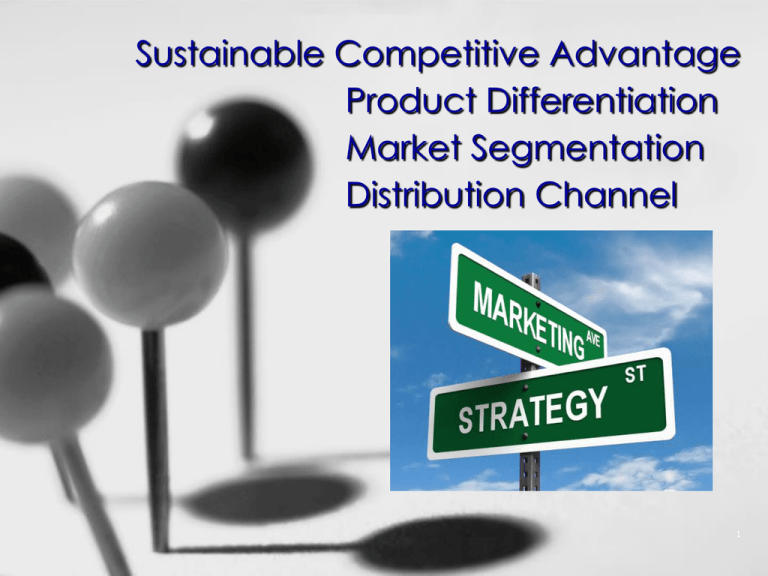
Sustainable Competitive Advantage
Product Differentiation
Market Segmentation
Distribution Channel
1
Marketing Strategy: Essential Questions
How is Product “Meaningfully
Different?”
Who is Customer (Market)?
Why will Customer “Switch” to
my Product and be “Loyal?”
2
Obtain “AND” Sustain
Competitive Advantage
Objective
Firm has a Competitive Advantage
when Competitors cannot Duplicate
the Value-creating Processes of
its Product and Market Position
VALUE created by…
1) Differentiating Product in
Meaningful Ways,
2) Targeting an Under-served Market
Segment (Target Market) and
3) Using an Effective Distribution
Channel
3
What’s your “Overall Strategic Concept?”
It’s also your “Value Proposition”
It’s the “Unique Value” your
Business and Product delivers
It’s why customers will want to
do Business with you
1. Identify WHO will Buy your Product
2. Describe WHAT your Product does that’s
Faster, Better or Cheaper than Competitors
3. PERSUADE Prospective Customers to
Switch to Buying/Using your Product
4
Sustainable Competitive Advantage
Marketing: The “Four-Ps”
Product: How is it Different?
Price: Price/Attributes Relationship
Place: Distribution Channel
Promotion: Communicate Message
5
Distribution Channel Analysis
Use the Five “Cs” Analytical Tool
How did Costco revolutionize
distribution channels?
6
Sustainable Competitive Advantage
Michael Porter’s
“Five Forces”
Competitive Analysis
7
Sustainable Competitive Advantage
SUPPLIERS
“Uniqueness”
Cost/Time to Replace
BARRIERS
Ease of Entry
Cost/Time to
Duplicate
COMPETITORS (Market)
Number, Diversity and
Concentration
Differentiation
SUBSTITUTABILITY (Product)
Switching Costs (Loyalty)
Ease/Willingness to Substitute
BUYERS
Number and Concentration
Price Elasticity
8
"This is the market group
we'll be targeting"
Dave Carpenter
Copyright 2002, Harvard Business Review
9
Sustainable Competitive Advantage
Products Differentiate in ONLY
Two Ways - No More, No Less
PRICE – Can you Win a
“Price War” with Wal-Mart?
ATTRIBUTES – What are
these? Do they build
Customer Loyalty?
10
Product Differentiation
Set of Meaningful Differences…
Designed to Distinguish a
Firm’s Product or Service…
From its Competitors
Note: “Meaningful” equates with Long-Term
Financial Value, Not Unsustainable
Short-term Windfall
11
Product Differentiation
DIFFERENTIATION VARIABLES
Physical Form: Size, Shape or
Coloring of Product or Packaging
Functional Features: Supplements
to Product’s Basic Function
Quality: Affects Product’s
Operation - Reliability and
Durability
12
PRODUCT
HEADLINE: The Meaningful Difference
DIFFERENTIATION Customers will see and want is _______.
VARIABLES
Our
Product
Our
Competitors
A
B
C
Physical Form
Product/Package Size, Shape or Coloring
Functional Features
Supplements to Basic Function
Quality
Product Use - Reliability and Durability
ANALYSIS
13
Product Differentiation
DIFFERENTIATION EXAMPLES
Customers
really bit on
this idea!
14
Market Segmentation
IDENTIFY RELEVANT SEGMENT
Mass Marketing: Mass Production,
Distribution and Promotion of Single
Product for All Buyers
Segment Marketing: Large, Identifiable
Group with Similar Buying Attitudes and
Habits, Purchasing Power and Preferences
Niche Marketing: “New” Small Market with
Unserved (not under-served) Needs
15
Market Segmentation
IDENTIFY COMMERCIALLY VIABLE
GROUP WITHIN MARKET SEGMENT
WITH SIMILAR…
Tastes and Preferences
Purchasing Power (Economics)
Geographical Location, Age, Gender
(Demographics)
Purchasing Patterns and Habits
(Sociological)
16
SEGMENTATION
ANALYSIS
HEADLINE:
Our Customers are _____
and they will want to buy (and keep
buying) our Product because _________
TARGET MARKET’S
CHARACTERISTICS
Our
Product
Our
Competitors
A
B
C
Demographics
Age, Sex, Marital Status, Location
Economics
Income (Disposable)
Psychological-Sociological
Tastes, Preferences, Buying Patterns/Habits
ANALYSIS
17
Oregonians: Who are We?
Not Many “Native Oregonians” – 64% of
Growth from 2000-2008 was In-migration
Live in Urban Areas just like Rest of Country –
Urban (79%) and Rural (21%)
Older than National Average – Fewer younger
than 25 and More older than 45 years old
Poorer than Rest of Country
18
Market Segmentation
19
Marketing Strategies
Mass
Marketing
Any Color "as
long as it's
black"
Undifferentiated
Segment
Marketing
Different car for
Different
People
Differentiated
Niche
Marketing
Ferrari is for a
Very Small
Special Group
Concentrated
One-off
Product
Local or
Individual
Micromarketing
Local and
Individual
20
Distribution Channels
How do
Customers
(1) Buy
(2) Use and
(3) Replace
or Upgrade
Product?
21
DISTRIBUTION
CHANNEL
HEADLINE:
Our Customer’s Questions
about how to Buy and Use our Product
will be answered by ________.
NECESSARY INFORMATION
AND PROCESSES
Our
Product
Our
Competitors
A
B
C
How do Customers Decide to Buy?
How is Information Obtained?
How do Customers Buy?
How is Product Delivered?
How do Customers Use Product?
Repairs, Maintenance, Upgrades?
ANALYSIS
22
Strategic Marketing Analysis
PROBLEM
New York Times
wants to Charge for
Frequent Access to
Web Site
Product
Differentiation
Certain Number of
Articles for Free; Flat Fee
(Subscription) for
Unlimited Access
Limited Number for
Free; Unlimited Access
for Print Subscribers
10 Articles/Month to
Non-subscribers;
Unlimited Access for
Print Subscribers
Market
Segmentation
Most popular Newspaper
Website (17M monthly
readers). How many will
pay for access?
US Business
Newspaper of Record.
Business versus
Personal Subscribers?
International Business
Newspaper
Business versus
Personal Subscribers?
Distribution
Channel
Wants Proprietary
System; Communicate
seamlessly with Print
Subscribers Database
Straightforward Pay
Wall
“Metering System”
23
TOOLS: SWOT Analysis
STRATEGIC DEVICE FOR
IDENTIFYING AND ANALYZING:
Strengths: Internal Capabilities to
Expand Product Market Share
Weaknesses: Vulnerabilities in Product
Mix or Line
Opportunities: External Market or
Competitor Conditions
Threats: External Macroeconomic or
Industry Factors
24
TOOLS: SWOT Analysis
INTERNAL
Strengths
EXTERNAL
Weaknesses
Do our
Will we miss
Strengths and
Opportunities
Likely
Opportunities
because we lack
Opportunities
Certain Strengths?
match up?
Can we
Do our Weaknesses
Minimize/Avoid
make us Vulnerable
Threats
Threats with our
to Threats?
Strengths?
If you ask the right questions, the answers are easy…
25
PRODUCT
LIFE
CYCLE
Useful Strategic Planning/Analysis Tool
Modify to Include all Life Cycle Cash Flows
Uncertainty Element: How do you know
the Curve’s future direction?
26
Aspects Of Differentiation
PRODUCT MIX STRATEGY
Distinct from Product Line Extension
Broaden Range with Unrelated
Product Types
Risk Diversification Strategy: Mitigate
Seasonal or Cyclical Volatility
27
Aspects Of Differentiation
PRODUCT LINE EXTENSION
Tactical Implementation of
Differentiation Strategy
Maintain Core Product but
Supplement with Enhancements
and Related Products
Has Effect of Extending Overall
Product Life Cycle
28
Perceptual Map of Breakfast Cereals
GOOD
TASTE
Cocoa Puffs
LOW
NUTRITION
HIGH
NUTRITION
Rice
Krispies
Cheerios
Wheaties
Shredded
Wheat
BAD
TASTE
29
Perceptual Map:
Contrasts Primary Competitive Dimensions
Each “Brand Bubble”
is “Mapped” based
Perceived
Competitive
Dimensions: Price
versus Quality
How is Industry competitively
divided by Price and by Quality?
Another Approach: Evaluate
other Non-price Benefits - Variety
of Styles or Return Policy
30
A Strategic Marketing Assignment
THE OPPORTUNITY
Should we buy a Circus?
How would you decide whether
this makes sense?
31
Evaluate External Environment?
RIVALS: Big League National Player (Ringling Bros) and
Lots of Little League Regional Players
RESOURCES AVAILABILITY: Few Big Names (Expensive)
and Highly Specialized (Sword Swallowers)
SUBSTITUTES: Other Live Entertainment, Video Games,
Recreation
32
How to Differentiate Product?
TRADITIONAL INDUSTRY
STRUCTURE
INNOVATIVE
DIFFERENCES?
Used to be in a Tent
Bring back the Big Top
Three Rings
One Ring
Animals
No Animals
Unrelated Acts
Story/Theme
Emphasize Fun/Thrills/Danger
Emphasize Music and Artistry
Low Entry Price and High
Concessions Sales
High Entry Price as Primary
Revenue Source
33
Who’s our Market?
TRADITIONAL
INDUSTRY STRUCTURE
INNOVATIVE
DIFFERENCES?
Young Children
Older Children
Young Children’s Parents
Adults of All Ages
Price-Elastic (Low Price)
Price-Inelastic (High Price)
Must Take Children to Circus
Also go to Opera, Symphony,
Plays and Musicals
Not likely to Go Again after
Children Grown
Will be Repeat Customers if
Different Themes/Venues offered
34
Four Actions Framework: Answer Four Questions
to Discover Key to “New Value”
REDUCE
What Industry practices should not be done?
ELIMINATE
What has
Industry taken for
granted that
should be
eliminated?
Create New
Markets
with New
Value
CREATE/ADD
What has Industry
never offered that
should be created
or added?
RAISE
What should be done at a level above Industry practices?
35
Eliminate-Reduce-Raise-Create
ELIMINATE
Star Performers and Animals
Reliance on Concessions
Unrelated Acts
REDUCE
Thrills and Danger
Fun (versus Humor)
RAISE
Unique Venues
CREATE
Artistry and Music
Themed Story with Humor
Multiple Venues
36
STRATEGY CANVAS
HIGH
Ringling Brothers
Cirque du Soleil
Smaller Regional Circus
Offering Level
Low
Price
Animal Shows
Star Performers
Multiple Show
Arenas
Aisle Concessions
Thrills & Danger
Fun & Humor
Theme
Unique Venue
Multiple
Productions
Refined Viewing
Environment
Artistic Music
37
& Dance
The Strategy Canvas
Eliminate
Reduce
Raise
Create
Ringling Brothers
Cirque du Soleil
Smaller Regional Circus
Price
Animal Shows
Star Performers
Multiple Show
Arenas
Aisle Concessions
Thrills & Danger
Fun & Humor
Theme
Unique Venue
Multiple
Productions
Refined Viewing
Environment
Artistic Music
38
& Dance
When the Motor home has come to a
full and complete stop, Exit only through
the Front Cabin Door…
39




